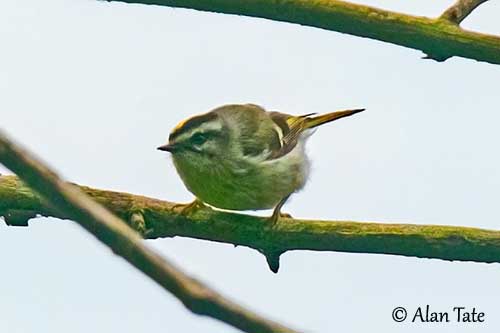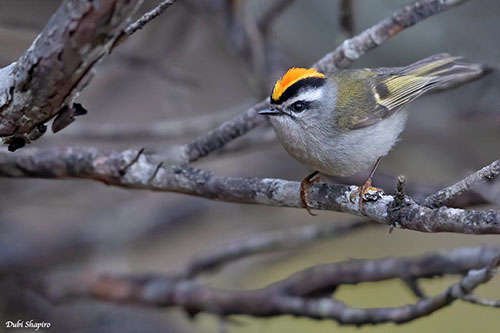
PROTECTION / THREATS / STATUS:
The Golden-crowned Kinglet is usually common throughout the wide range.
However, some populations may decline when affected by very harsh cold weather on their wintering grounds. But local populations are stable with only slight variations.
The species has expanded the breeding range into new areas in NE, where it nests in conifer plantations.
The Golden-crowned Kinglet is not considered globally threatened and the species is currently evaluated as Least Concern.
Fr: Roitelet à couronne dorée
Ang: Golden-crowned Kinglet
All: Indianergoldhähnchen
Esp: Reyezuelo Sátrapa
Ita: Regolo capodorato
Nd: Amerikaanse Goudhaan
Sd: guldkronad kungsfågel
Photographers:
Tom Grey
Tom Grey's Bird Pictures & Tom Grey's Bird Pictures 2
Ken Havard
My Bird Gallery & Flickr gallery 1 & Flickr gallery 2
Dubi Shapiro
Dubi Shapiro Photo Galleries
Alan & Ann Tate
AA Bird Photography
Text by Nicole Bouglouan
Sources:
HANDBOOK OF THE BIRDS OF THE WORLD Vol 11 by Josep del Hoyo, Andrew Elliott and David Christie - Lynx Edicions - ISBN: 849655306X
BIRDS OF THE GREAT BASIN – by Fred A. Ryser - Univ of Nevada Pr -ISBN: 0874170796
A GUIDE TO THE BIRDS OF MEXICO AND NORTHERN CENTRAL AMERICA by Steve N. G. Howell, Sophie Webb - Oxford University Press - ISBN: 0198540124
Animal Diversity Web (University of Michigan Museum of Zoology)
South Dakota Birds and Birding – (Terry L. Sohl)
What Bird-The ultimate Bird Guide (Mitchell Waite)
Wikipedia, the free encyclopaedia
Golden-crowned Kinglet
Regulus satrapa
Passeriformes Order – Regulidae Family
INTRODUCTION:
The Golden-crowned Kinglet is a North American species that breeds in the northern coniferous forests and winters throughout a large part of the continent in other habitat types such as taiga, suburban and swamps environments.
It is primarily an insect-eater, but seeds and some fruits are occasionally part of its diet.
The species is monogamous. The nest is a cup-shaped structure hanging from a branch in conifer tree. The female incubates alone but both parents feed the chicks.
The birds breeding in the northern part of the range are migratory and move southwards after breeding. The other populations are mainly resident.
The Golden-crowned Kinglet has very large range and is described as “common”, with only some local declines, whereas some populations are currently increasing. It is not globally threatened.
DESCRIPTION OF THE BIRD:
Biometrics:
Length: 8-11 cm
Weight: 5-6 g
The Golden-crowned Kinglet male of nominate race has greyish neck and nape and olive-green upperparts, especially on mantle and scapulars. On the upperwing, the blackish flight-feathers are conspicuously edged yellowish. The secondaries have black bases forming a broad band on closed wings. The tertials are edged and tipped whitish. There are two white wingbars.
Throat and underparts are creamy-white to pale grey, with buff wash on flanks.

The head pattern is prominent. The crown is bright yellow with some erectile orange feathers mixed in. Two broad, black lateral stripes meet on the forehead. A white supercilium extends to the middle of the ear-coverts. The lores are white. There is a narrow white stripe below the eye contrasting with the black eyestripe. We can see a thin, black moustachial stripe.
The thin, needle-like bill is black. The eyes are dark brown. Legs and feet are brownish yellow.
The female has similar plumage but she lacks the orange crown feathers.
The juvenile shows indistinct head pattern and the crown is grey.
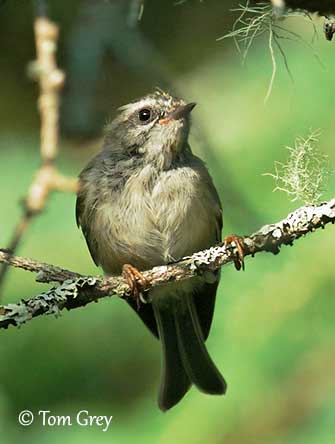
SUBSPECIES AND RANGE:
The Golden-crowned Kinglet has five subspecies varying mainly in coloration, from dull to brightly coloured plumage.
R.s. satrapa (described above) breeds from NE Alberta, E to Newfoundland and S through New England, New York and Appalachian Mts to E Tennessee and W North Carolina.
It winters through S Canada, S to Florida and NE Mexico, and W to C Colorado.
It is casual in West to SW California, S Nevada and SE Arizona.
R.s. olivaceus breeds from SE Alaska and W British Columbia, S to SW Oregon and (perhaps) NW California. It winters along the coast from SW British Columbia to SW California.
This race is smaller than nominate, but with longer bill. It is darker and greener above, the head side is brownish, the supercilium is longer and the wing pattern is less strongly contrasting.
R.s. apache breeds in the mountains of S Arizona and winters to S Texas and New Mexico.
This one is larger and greyer than “olivaceus”, with pale greyish head side.
R.s. aztecus is resident in SC Mexico.
This race is dark greenish above and the wing pattern is poorly developed. The underparts are washed greyish-brown.
R.s. clarus is resident in the mountains of S Mexico and S Guatemala.
This race is paler and duller below than “aztecus”, with shorter tail.
HABITAT:
The Golden-crowned Kinglet usually breeds in dense coniferous forests, especially spruce, fir and hemlock, up to 2,700 to 3,400 metres of elevation.
During migration and winter, it is mainly found in deciduous forests although it prefers conifers, and even pine groves and conifer plantations in suburban parks and cemeteries.
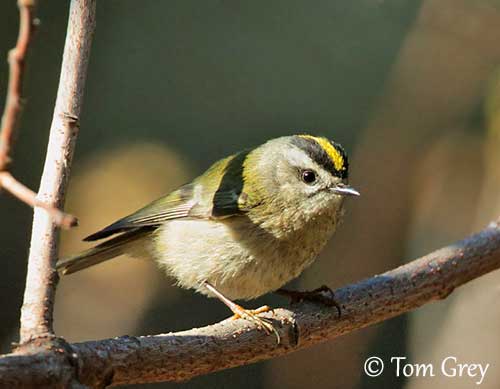
CALLS AND SONGS: SOUNDS BY XENO-CANTO
The Golden-crowned Kinglet uses contact calls to communicate within a flock, or between mates and with their young.
The thin calls of this species are often confused with the calls of the Brown Creeper. These calls are described as “tsee”, “see-see” or “ti ti”. The “see,see,see” of the kinglet is broken into syllables, whereas the Brown Creeper long “scree” is not. The faint, high-pitched song of the Golden-crowned Kinglet male is a thin series accelerating into a buzzy trill “tsi-tsi-tsi-tsi-tsi-si-sisisisisisizzzi”.
Both mates sing during nest-building and while foraging. Both parents also communicate with their young, allowing them to find their fledglings by exchanging calls.
The song of this kinglet varies in length and complexity according to specific behaviours.
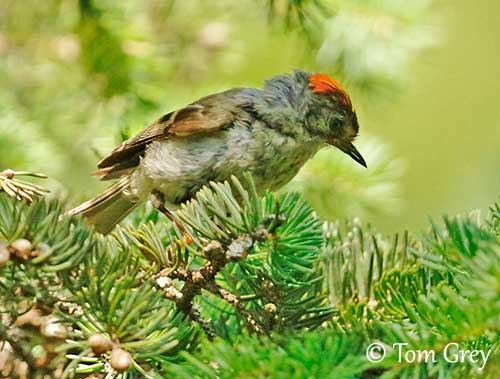
The Golden-crowned Kinglet of the northern parts of the range is mainly migratory, but the species is resident in a large part of the continent, both in west and east.
The races “aztecus” and “clarus” are resident in S Mexico.
The flight can be fast and erratic over long distances. This species has weak fluttering flight with rapid, shallow wingbeats interspersed with brief pull of wings to sides. It frequently hovers over a food item before dipping down to pick it up with the bill.
REPRODUCTION OF THIS SPECIES:
The breeding season takes place from May to August, with nest-building in early May followed by the laying.
The deep hanging cup is built in conifer, between 8 and 20 metres above the ground in radiating twigs. This structure is attached to hanging twigs below a horizontal branch and close to the trunk. There is usually some foliage above used as shelter. The nest is made of moss, lichens, bark strips, spider webs, twigs and leaves. The cup is lined with softer materials such as feathers, vegetal down, rootlets, animal hair and others.
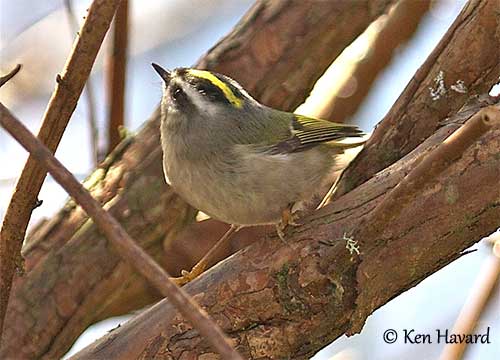
The female lays 8-9 to 5-11 whitish to pale buff eggs with grey spots. This is a surprising number of eggs for this small bird. The eggs are often placed in two layers in the nest. The second clutch of the season is usually slightly smaller.
The female alone incubates during about two weeks. She is usually fed by the male during this period.
The chicks are fed by both parents. They leave the nest about 16-19 days after hatching and they depend on parents for food for 16-17 days before to become independent.
The second clutch starts only one day after the young have left the nest. The male continues to feed the newly fledged young alone. A second nest is built for the second clutch.

BEHAVIOUR IN THE WILD:
The Golden-crowned Kinglet is primarily an insect-eater. It feeds on a wide variety of insects such as small beetles, gnats, caterpillars, aphids and others. It also takes spiders, and consumes occasionally sap, seeds and small fruits.
It usually forages in conifer trees and shrubs, and often hangs upside down from tips of twigs. It also engages in aerial gleaning, fluttering or hovering in front of the foliage to glean small insects and spiders. It may perform flycatching to capture passing insects.
It is very active, almost continuously moving, opening and closing the wings when perched. Outside of breeding season, it joins mixed-species foraging flocks.
The Golden-crowned Kinglet is monogamous during a single season. The male defends the territory by singing. Aggressive encounters may occur with other rival males, during which the kinglet leans forwards and down while the orange crown feathers are raised. Wings and tail are flicking while it is singing.
The nest is a deep hanging cup built by the female in conifer tree.
